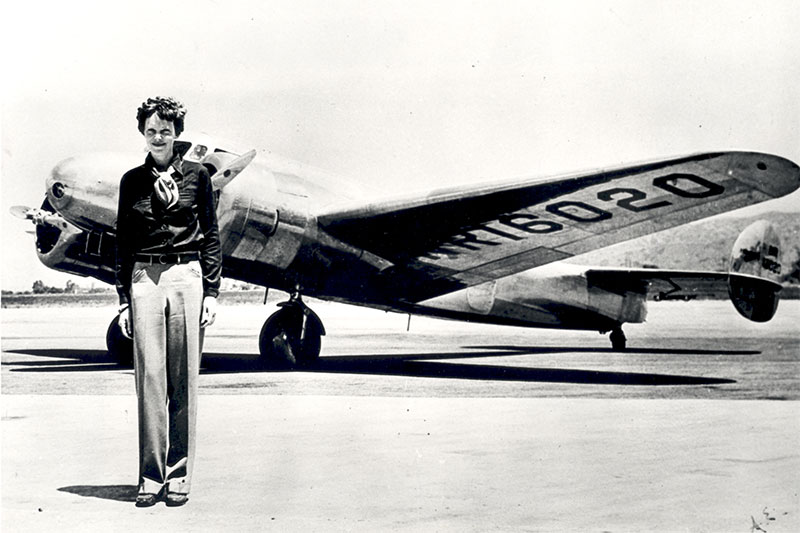When Amelia Earhart disappeared near Howland Island in 1937, she had no way of knowing that her legacy would be her disappearance and not her life. We have celebrated the wrong Earhart, a woman who disappeared at sea when we should have been celebrating who she truly was: a woman who, in spite of the men who failed her in her life, embraced her free-spirited nature and who could inspire a sense of adventure and excitement in all women. The real Amelia Earhart is more of a symbol of feminist perseverance than aviation.
She was born to parents who spent money faster than they could find it, and her father usually drank any income that came his way. By all definitions at the time, she was a tomboy and kept a scrapbook of women who went into male-dominated professions. From the time she was a small child, Earhart’s mother shuttled Amelia and her sister between her family home and her grandparents in an attempt to give the girls security. By 10-years-old, a young Amelia Earhart had learned to be independent and not rely on anyone to take care of her.
Earhart began learning to fly in 1920 with a female instructor, becoming the 16th woman in the world to obtain a pilot’s license. However, after her father had gone through her mother’s inheritance and her parents divorced, Earhart sold her plane to help her mother. Soon after, she was given an opportunity to fly the Atlantic, an opportunity not yet attempted by a woman. Approached by publicist and pilot Captain Hilton H. Railey and publisher George P. Putnam to be included in the flight, Earhart was, at first, enthusiastic until she met with them.
The men felt it was too dangerous for a woman to conduct a transatlantic flight and so Amelia Earhart was regulated to the backseat of the plane as a passenger. Amelia was later quoted as saying she “felt like a sack of potatoes” and was determined to later try the flight on her own. She wasn’t going to be anyone’s sack of potatoes, even George P. Putnam’s.
After the international flight, and after hiring Putnam as her manager, Earhart began lecturing and writing about aviation around the country. Frustrated by how little social and economic independence women had, Female pilots, formed The Ninety-Nines (99s) to promote the social, recruitment and business purposes of women pilots. They chose Earhart as their first president. She also became the first woman vice president of the National Aeronautic Association, an organization that authorized official records and races. Her primary agenda was to convince the organization to establish separate female records. Since women pilots didn’t have the money or planes they didn’t have comparable experience to men, thus they couldn’t fairly compete against men for world titles. But they could compete against each other.
George P. Putnam saw in Earhart great publication and other moneymaking opportunities. After publishing and promoting two books, Putnam kept her on a busy touring schedule lecturing across the country, writing articles for Cosmopolitan—eventually becoming its associate editor—and becoming a partner for Transcontinental Air Transport and Ludington Airlines. When would she have time to continue her flight training?
Marrying George P. Putnam only made Earhart’s schedule busier than before. Insisting on keeping her married name, Putnam soon began to be referred to as “Mr. Earhart” and realized that was part of the Earhart package.
Unfortunately, the real Amelia Earhart, not the one that people want to romanticize, was not a brilliant aviator.
She kept up in aviation during the first decade of the century but wasn’t able to keep up with the swift technological advances. The relentless promoting schedule created by Putnam made it difficult to keep up with the evolving radio and navigation equipment, forcing Earhart to fly by instinct. That’s not to say that Earhart was blissfully ignorant to her limitations. She continuously worked to improve her skills, but the constant promoting and touring, which now included a position as a visiting professor at Purdue University, wasn’t conducive to the consistent training schedule necessary to remain caught up.
By the time it came to Earhart’s world flight, her mediocre ability, and inability to remain in line with the latest technology would come to be a grave issue. A series of poor decisions ultimately led up to her plane going down. Her navigator, Fred Noonan, possibly unable to navigate by the stars due to cloud coverage, was using inaccurate maps the night their plane went down. A shortwave radio was left behind. Earhart used the wrong frequency (Greenwich Civil Time vs. Naval Time Zone) for a check-in time. Some of the factors leading to Earhart’s plane going down were unavoidable, the weather for example or the possibility of a damaged radio antenna. However, other issues were avoidable and should have been caught by her navigator or, realistically, should have been prevented by Earhart being better prepared if Putnam had permitted it in her schedule.
The real Amelia Earhart is more than a mysterious disappearance in the ocean. She is more than her ability to fly or her unfortunate childhood.
Amelia Earhart is an icon of what women have struggled with for centuries: a woman who relied on the men in her life to provide for her and who ultimately failed her.
Amelia Earhart learned at a young age the importance of being independent yet also knew the strategic importance of working within the confines of a male-dominated world. That world failed her, and it cost her her life. The only mystery that matters now is not what happened to her but what we do now. Earhart didn’t make it in her circumnavigation; her sense of adventure and independent nature was who the real Amelia Earhart was and who we should all strive to be.

Fascinating story, so much I did not know about Amelia Earhart, one of my personal heroes. Good luck in your aviation career–no unnecessary stops is a great motto!